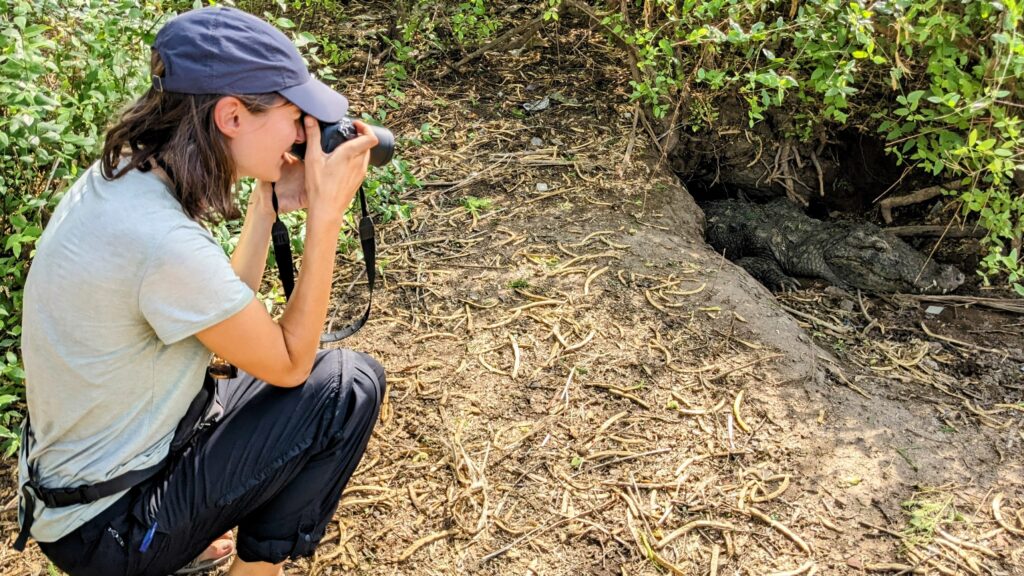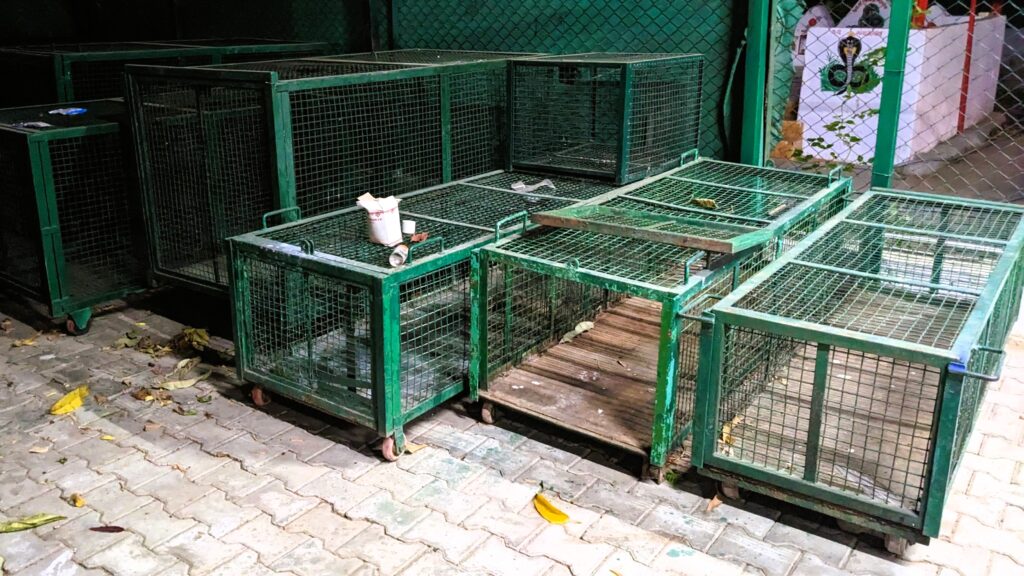Vadodara is a city of 4 million inhabitants in the state of Gujarat in India. Its name comes from the abundance of banyan trees (‘vad’) and it is an important center located on the highway between Delhi and Mumbai, the country’s two biggest cities. Normally not a destination that would be on our radar for Biking4Biodiversity. But that changes with the invitation of Bhautik Desai, a naturalist and expert in animal rescue. He tells us he wants to show us around his hometown called the city of crocodiles.
The first encounter
Approaching Vadodara, we understand why it is named after the banyan trees that become more abundant with every turn. But we don’t see any signs of crocodiles. As we arrive at Bhautik’s place, he tells us that this will change in the evening. After sunset we head out and drive to a big bridge over the Vishwamitri river. We can’t imagine that we would see many crocodiles underneath this busy bridge, but when Bhautik shines his torch along the bank of the river, dozens of eyes shine back at us like stars in the sky. These eyes all belong to marsh crocodiles (Crocodylus palustris) more commonly called muggers. They are scattered all across the river and its banks, sometimes even in groups of 5-6 animals. We cannot believe our eyes as we count around 30 animals just around this busy bridge.


During the next day, we learn more about the crocodile population of Vadodara. While muggers are widespread all across the Indian Subcontinent, Vadodara is the only major city that has a viable population with around 300 individuals. The surrounding villages are also densely populated, amounting to a population of almost 1500 in the whole district. This population – and partly the conflict it causes – has brought Vadodara the reputation as the city of crocodiles.
How do crocodiles live in a city?
The first question on our mind is what all these crocodiles eat. Naturally, there is not much wild prey along this river that is lined with buildings causing high disturbance. Bhautik tells us that an important part of their diet are actually leftovers from butchers and slaughterhouses that apparently throw bones, trimmings and so on right into the river. The rest of their diet is made up of the animals that are abundant in all Indian cities, mostly feral dogs and cows. The second question in our mind is whether the rampant pollution we can see everywhere along the river doesn’t bother them. Some of the individuals we observe are literally lying on top of trash piles. But we conclude that a species that has survived several mass extinctions can probably adapt to a lot of things.


While the crocodiles have adapted to several downsides of living amongst humans, many humans are not willing to do the same. During the monsoon, when the river swells, muggers leave their usual habitats down by the river and come closer to human settlements. Online, one can easily find plenty of stories of crocodiles appearing around buildings, either swimming there during floods or finding their way there through flood drains that run across the whole city. This problem is further increasing as more expensive residential buildings offering a magnificent river view are being built along the Vishwamitri and other rivers, which are all inhabited by muggers.
Villages of crocodiles
To learn more about the traditional coexistence between humans and crocodiles, we visit the village of Malataj, where we meet Anirudh Vasava of VNC India. Anirudh, a wildlife biologist with extensive experience in human-wildlife conflict, chose this village because it is a best-practice example of human-crocodile coexistence. In Malataj and many villages around, humans live even closer with the muggers than in Vadodara. They inhabit many ponds in the area that humans use for fishing, washing laundry and many other things. We hear stories of women washing clothes a few meters away from basking crocodiles and fishermen living right next door to the muggers. While one could expect that especially the fishermen do not like them, Aniruth tells us that most of them in fact accept their presence and see the benefits. Similar to a guarding dog, crocodiles need to eat, but in return they keep poachers away from the pond and maintain a healthy fish stock.


According to Anirudh, many people here not only accept the crocodiles, but ‘love’ them and are very proud of the healthy population. Even if a family member gets killed or someone gets attacked themselves when crossing a pond or channel inhabited by crocodiles, they do not blame the mugger that simply followed its natural instincts, but try to learn from it and change their behavior. This openness and wise attitude even shocked Anirudh when he moved to this region, and he recalls several scenes when he saw children playing in the water, women washing clothes and in the background, crocodiles basking comfortably in the sun. Based on many years of experience, he lists several reasons why coexistence works so well here compared to many other places in India:
- People in Malataj have specific fenced-off access points to ponds. Organizations such as VNC work to build even more such access points.
- Crocodiles live across many ponds and streams that are all interconnected by channels, allowing movement in times of water or food scarcity.
- Compared to Malataj and the neighboring villages, in Vadodara there are insufficient bridges and other infrastructure to cross the river with livestock, which can lead to more attacks.
- Locals in Malataj have a lot of knowledge about crocodile behavior after living together with them since childhood. In cities, a lot more newcomers move into mugger habitats without knowing anything about them.
Meeting the old lady
We experience first-hand just how closely humans and crocodiles coexist, when Anirudh guides us into a thicket just behind a house on the edge of another village. Unsuspecting, we stop a few meters away from the house on a path that people and livestock use regularly to access the near-by channel. Anirudh points our attention towards a big hole in the ground just next to the path and we realize that it is a burrow with a over 2m long female mugger lying in its entrance. Even though we are a group of six people, including a local boy from a nearby house talking and moving closer, she does not make a single movement. Anirudh tells us that she has lived here for many years and got so used to humans that one could even go and touch it. Needless to say, that is still not a smart idea. This female also doesn’t care about the buffaloes and other livestock that regularly pass by, but rather goes to the channel to hunt fish and smaller prey.


The Crocodile Conservation Project
That the mugger populations are striving is not only due to successful coexistence, but also partly thanks to a national initiative: the ‘Crocodile Conservation Project’ that the Indian Government launched in 1975. After all three crocodile species that occur in India – the marsh crocodile, gharial and saltwater crocodile – were brought close to extinction, this project mobilized immense efforts to grow their populations by restoring habitats and reintroducing bred individuals into their former habitat. But especially the muggers are increasingly causing issues. While coexistence in villages works well, in Vadodara and other cities ongoing construction along the waterways is harming their habitat. Back in Vadodara, Jitendra Gavali from the Community Science Center in Vadodara tells us that the city council planned to completely channelize all rivers in the city, supposedly to prevent flooding, but destroying every last piece of crocodile habitat in the process. A protest of the locals could luckily stop these plans in 2017, mainly because the plan was half-baked and not thought-through. But of course this verdict won’t last for eternity and many still propose a channelization.
‘Crocodile lovers’
VNC and other NGOs work hard to raise awareness about how special this case of coexistence is and what are the ways forward to protecting the mugger population. They conduct an annual crocodile count that involves many local volunteers and thus include citizen science in their conservation. They also help the forest department with crocodile rescue from residential areas or places where they are trapped. Bhautik has many stories of nightly calls to rescue muggers from all kinds of places. Once they get a call, they catch the crocodiles as quickly and gently as possible and bring them to the forest department’s rescue center, from where all rescued animals are released back into a suitable habitat.


As we leave Vadodara, we hope that it will remain the city of crocodiles in the future. This example of coexistence is unique and an inspiration for cities around the globe. Unfortunately, ongoing development is threatening the status quo and Malataj showed us that the key to successful coexistence is acceptance, curiosity and knowledge about the species. NGOs like VNC and passionate individuals like Bhautik are working tirelessly to preserve this treasure and educate people about crocodiles, hoping to instill that same love that they already feel for these misunderstood creatures.

Pingback: Achanakmar – a reserve at a crossroads - biking4biodiversity.org